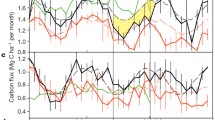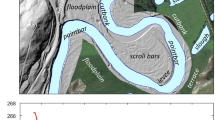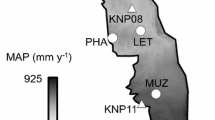Abstract
DEFORESTATION and logging transform more forest in eastern and southern Amazonia than in any other region of the world1–3. This forest alteration affects regional hydrology4–11 and the global carbon cycle12–14, but current analyses of these effects neglect an important deep-soil link between the water and carbon cycles. Using rainfall data, satellite imagery and field studies, we estimate here that half of the closed forests of Brazilian Amazonia depend on deep root systems to maintain green canopies during the dry season. Evergreen forests in northeastern Pará state maintain evapotranspiration during five-month dry periods by absorbing water from the soil to depths of more than 8m. In contrast, although the degraded pastures of this region also contain deep-rooted woody plants, most pasture plants substantially reduce their leaf canopy in response to seasonal drought, thus reducing dry-season evapotranspiration and increasing potential subsurface runoff relative to the forests they replace. Deep roots that extract water also provide carbon to the soil. The forest soil below 1 m depth contains more carbon than does above-ground biomass, and as much as 15% of this deep-soil carbon turns over on annual or decadal timescales. Thus, forest alteration that affects depth distributions of carbon inputs from roots may also affect net carbon storage in the soil.
Similar content being viewed by others
References
FAO Forestry Pap. 112 (FAO, Rome, 1993).
Fearnside, P. M. Ambio 22, 537–545 (1993).
Skole, D. & Tucker, C. Science 260, 1905–1910 (1993).
Chahine, M. T. Nature 359, 373–380 (1992).
Dickinson, R. E. & Henderson-Sellers, A. Q. Jl R. met. Soc. 114, 439–462 (1988).
Victoria, R. L., Martinelli, L. A., Mortatti, J. & Richey, J. Ambio 20, 384–387 (1991).
Shuttleworth, W. J. et al. J. Hydrol. 129, 71–85 (1991).
Nobre, C., Sellers, P. & Shukla, J. J. Clim. 4, 957–988 (1991).
Shukla, J., Nobre, C. A. & Sellers, P. Science 247, 1322–1325 (1990).
Lean, J. & Warrilow, D. A. Nature 342, 411–413 (1989).
Salati, E., Dall'Olio, A., Gat, J. & Natsui, E. Wat. Resour. Res. 15, 1250–1258 (1979).
Houghton, J. T., Jenkins, G. J. & Elphraums, J. J. (eds) Climate Change. The IPCC Scientific Assessment (Cambridge Univ. Press, New York, 1990).
Houghton, J. T., Callander, B. A. & Varney, S. K. (eds) The Supplementary Report to the IPCC Scientific Assessment (Cambridge Univ. Press, New York, 1992).
Houghton, R. A. Clim. Change 19, 99–118 (1991).
Uhl, C., Buschbacher, R. & Serrão, E. A. S. J. Ecol. 76, 663–681 (1988).
Nepstad, D. C., Uhl, C. & Serrão, E. A. S. Ambio 20, 248–255 (1991).
Mattos, M. M. & Uhl, C. Wld Dev. 22, 145–158 (1994).
Richter, D. D. & Babbar, L. I. Adv. Ecol. Res. 21, 315–389 (1991).
Nepstad, D. C. thesis, Yale Univ. (1989).
Potter, C. S. et al. Globl Biogeochem. Cycles 74, 811–841 (1993).
Sombroek, W., Nachtergaele, F. O. & Hebel, A. Ambio 22, 417–426 (1993).
Trumbore, S. E. Globl Biogeochem. Cycles 7, 275–290 (1993).
Veldkamp, E. Soil Sci. Soc. Am. J. 58, 175–180 (1994).
Lugo, A. E. & Brown, S. Pl. Soil 149, 27–41 (1993).
Detwiler, R. P. Biogeochemistry 2, 67–93 (1986).
Fisher, M. J. et al. Nature 371, 236–238 (1994).
Poels, R. I. H. Soils, Water and Nutrients in a Forest Ecosystem in Surinam (Agric. Univ., Waageningen, The Netherlands, 1987).
Global Vegetation Index User's Guide (ed. Kidwell, K. B.) (NOAA, Washington DC, 1990).
Stone, T. A., Schlesinger, P., Houghton, R. A. & Woodwell, G. M. Photogram. Eng. and Rem. Sens. 60, 541–551 (1994).
Uhl, C., Kauffman, J. B. & Silva, E. D. Ciência Hoje 65, 25–32 (1990).
Topp, G. C., Davis, J. L. & Annan, A. P. Wat. Resour. Res. 16, 574–582 (1980).
Topp, G. C. & Davis, J. L. Soil Sci. Soc. Am. J. 49, 19–24 (1985).
Author information
Authors and Affiliations
Rights and permissions
About this article
Cite this article
Nepstad, D., de Carvalho, C., Davidson, E. et al. The role of deep roots in the hydrological and carbon cycles of Amazonian forests and pastures. Nature 372, 666–669 (1994). https://doi.org/10.1038/372666a0
Received:
Accepted:
Issue Date:
DOI: https://doi.org/10.1038/372666a0
- Springer Nature Limited
This article is cited by
-
Current and future distribution of Eucalyptus globulus under changing climate in Ethiopia: implications for forest management
Environmental Systems Research (2024)
-
The relationship between central Indian terrestrial vegetation and monsoon rainfall distributions in different hydroclimatic extreme years using time-series satellite data
Theoretical and Applied Climatology (2024)
-
First estimates of fine root production in tropical peat swamp and terra firme forests of the central Congo Basin
Scientific Reports (2023)
-
Modelling impacts of climate change and anthropogenic activities on inflows and sediment loads of wetlands: case study of the Anzali wetland
Scientific Reports (2023)
-
An empirical approach to predict regional organic carbon in deep soils
Science China Earth Sciences (2023)





